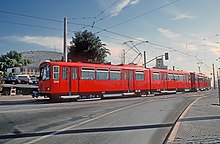San Diego Trolley
In 1975, the CPO published the Regional Transportation Plan which included a 58-mile (93 km) intermediate capacity fixed guideway system (an untested technology at the time) at a cost of $1.5 billion.
[8] The legislation was written and supported by State Senator James R. Mills, the President Pro Tem during this period and a strong transit advocate.
There would be several potential corridors to consider, including along freeways (Interstate highways I-5, I-8 & I-805 and State Routes 94 & 16), along existing railroad rights-of-way, and arterial roads.
In October 1977 the board selected light rail as the lone guideway transit technology to be studied (it would also be compared to several all-bus alternatives).
[8] Freight service was suspended, and in light of the extensive damages, SP petitioned the Interstate Commerce Commission to abandon the SD&AE on August 9, 1977.
In 1978, the Interstate Commerce Commission denied the request to abandon the SD&AE, prompting Southern Pacific to offer the railroad for sale to anyone willing to maintain freight operations on the line.
The MTDB stepped in and offered to buy the SD&AE for $18.1 million if the Southern Pacific fully repaired the hurricane-damaged line.
[10][8] The MTDB quickly secured a deal with the San Diego and Imperial Valley Railroad to continue freight service along the line.
[8] The first phase of the project cost $86 million, which included the purchase of the SD&AE, 14 light rail vehicles, construction of a single-tracked electrified light rail line along the 14.2-mile (22.9 km) SD&AE Main Line and construction of a 1.7-mile (2.7 km) section of new street running tracks in downtown San Diego.
[8] To control costs, only minor rehabilitation was conducted on the SD&AE corridor, with the MTDB replacing about 40% of the ties, welding the jointed rail, constructing electric catenaries, and installing an absolute block signal system.
[8] In August 1980, the MTDB established San Diego Trolley, Inc. to operate and maintain the new light rail system and on July 26, 1981, service began.
[6] In light of the strong ridership, construction of the second phase was started almost immediately, which involved double-tracking the SD&AE corridor and purchasing 10 additional vehicles.
[11] The San Diego Trolley added a second line on March 23, 1986, that shared the same downtown tracks and traveled east to Euclid Avenue on the La Mesa Branch of the SD&AE.
[6][7] The East Line's Bayside Connection extension to the San Diego Convention Center and Gaslamp Quarter opened on June 30, 1990.
But, the new vehicles could only operate on the Green Line, forcing passengers heading between Mission Valley and downtown San Diego to change trains in Old Town.
[13] Officials secured $660 million in funding after the 2008 election as voters passed the TransNet half-cent local sales tax and two statewide transportation bond measures.
Worn-out infrastructure was replaced as needed, including rails, ties, catenary wires, power lines and electrical substations.
[23] In 2011, SANDAG received key approval for the Mid-coast extension of the Blue Line,[24] running from Old Town Transit Center 11 miles (17.7 km) north to the University City community, serving major activity and employment centers such as Mission Bay Park, the University of California, San Diego (UC San Diego) campus, three major hospitals on (and adjacent to) the campus, and Westfield UTC mall.
Since the opening of the Copper Line, riders bound for Arnele Avenue, Gillespie Field, or Santee must transfer at El Cajon Transit Center.
Generally, trains operate every 15 minutes, seven days a week, with less frequent service during early morning and late evening hours.
Self-serve ticket-vending machines located at each station sell one-way paper tickets and passes (one day and monthly) on the Pronto Card.
[42] The Silver Line, operating only mid-days just four days a week (and with some service interruptions during the year), carried 29,104 passengers around the downtown loop in FY2014.
According to figures from APTA, previous to 2014, the San Diego Trolley achieved the highest level of ridership in 2007, when there were 36,386,100 unlinked passenger transits on the system over that entire year.
[52] The project study corridor runs between the City College Trolley Station area, and Balboa Park in the vicinity of the San Diego Zoo.
[60][61] Connecting service between the trolley and the airport is provided by local bus Route 992 that serves the Santa Fe Depot/America Plaza transit area.
[70] In April 2019, MTS again included the Purple Line in a final version of a November ballot initiative to increase the countywide sales tax by a half-cent to fund future transit plans.
These include a tram line (known simply as "Tram 555") from downtown to Hillcrest via Logan Heights; Commuter Rail 581 and 581B, connecting El Cajon to downtown and the Central Mobility Hub (a proposed transit center at San Diego International Airport), respectively; and Commuter Rail 583, which will connect the Central Mobility Hub with San Ysidro.
At the time, no purpose-built LRVs were being manufactured for the North American market, so the model was adapted for use by San Diego and other transit systems in Canada.
[92] Car 1035 was sold in late 2020 to the Memphis Area Transit Authority, which operates a vintage-trolley system and intends to use the LRV for testing of modern, higher-capacity vehicles on its Madison Avenue Line.
[93][94] In 1995, the San Diego Trolley purchased a fleet of 52 high-floor Siemens SD-100 vehicles, an evolution of the U2, but redesigned for the North American market.





